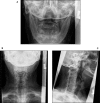Trigeminal neuralgia and chiropractic care: a case report
- PMID: 20808617
- PMCID: PMC2921783
Trigeminal neuralgia and chiropractic care: a case report
Abstract
The following case describes a 68 year-old woman with a 7(1/2) year history of worsening head and neck pain diagnosed as trigeminal neuralgia following surgical resection of a brain tumor. After years of unsuccessful management with medication and physical therapies, a therapeutic trial of chiropractic was carried out. Chiropractic care included ultrasound, manual therapies (manipulation and mobilization), soft tissue therapies, and home stretching exercises. After an initial treatment period followed by 18 months of supportive care the patient reported satisfactory improvement. It became evident that there were at least three sources of her symptoms: mechanical and/or degenerative neck pain, temporomandibular joint syndrome, and trigeminal neuralgia. While never completely pain-free, the patient continued to report that her pains reduced to minimal at times. At the most recent follow-up, the pain had not returned to pre-treatment intractable levels. This case study demonstrates the importance of diagnosing and treating multiple sources of pain and the positive role chiropractic care can have in the management of patients with these clinical conditions. The potential for convergence of sensory input from the upper three cervical segments and the trigeminal nerve via the trigeminocervical nucleus is discussed.
Le cas suivant décrit une femme de 68 ans qui présente un historique de 7,5 ans de douleurs qui s’aggravent au niveau de la tête et du cou.Le diagnostic : névralgie essentielle du trijumeau à la suite d’une résection chirurgicale d’une tumeur cérébrale. Après des années de tentatives de gestion infructueuses au moyen de médicaments et de physiothérapie, elle a suivi un essai de traitements thérapeutiques chiropratique. Les soins chiropratiques reçus incluent des ultrasons, de la thérapie manuelle (manipulation et mobilisation), des thérapies de tissus mous et des exercices d’étirement à domicile. Après une période initiale de traitement suivie de soins de soutien pendant 18 mois, la patiente a rapporté une amélioration satisfaisante. Il est devenu évident que ses symptômes découlaient de trois sources : douleurs mécaniques ou dégénératives au cou, syndrome de l’articulation temporomandibulaire, et névralgie essentielle du trijumeau. Bien qu’elle ne soit toujours pas entièrement libre de douleur, la patiente continue à rapporter que ses douleurs sont minimales à certains moments. Lors du suivi le plus récent, la douleur n’était pas revenue aux niveaux réfractaires prétraitement. Cette étude de cas démontre l’importance du diagnostic et du traitement des sources multiples de douleur, ainsi que le rôle positif que joue les soins chiropratiques dans la gestion des patients qui présentent ces troubles cliniques. Le potentiel pour la convergence de l’apport sensoriel provenant des trois nerfs rachidiens cervicaux supérieurs et du nerf trijumeau par le biais du noyau trigéminocervical fait l’objet d’une discussion.
Keywords: chiropractic; facial pain; head pain; neck pain; spinal nucleus; trigeminal neuralgia.
Figures




Similar articles
-
Atlas orthogonal chiropractic management of trigeminal neuralgia: A series of case reports.Explore (NY). 2024 Jan-Feb;20(1):70-78. doi: 10.1016/j.explore.2023.06.004. Epub 2023 Jun 16. Explore (NY). 2024. PMID: 37344335
-
Conservative Management of Trigeminal Neuralgia and Degenerative Cervical Myelopathy: A Case Report.Cureus. 2024 Feb 29;16(2):e55274. doi: 10.7759/cureus.55274. eCollection 2024 Feb. Cureus. 2024. PMID: 38558660 Free PMC article.
-
Chiropractic manipulation of anteriorly displaced temporomandibular disc with adhesion.J Manipulative Physiol Ther. 1995 Feb;18(2):98-104. J Manipulative Physiol Ther. 1995. PMID: 7790790
-
Update on Trigeminal Neuralgia.Curr Treat Options Neurol. 2019 Jul 31;21(9):42. doi: 10.1007/s11940-019-0583-0. Curr Treat Options Neurol. 2019. PMID: 31367794 Review.
-
Neurologic syndromes of the head and neck.Prim Care. 2014 Mar;41(1):133-49. doi: 10.1016/j.pop.2013.10.012. Prim Care. 2014. PMID: 24439887 Review.
Cited by
-
Essential literature for the chiropractic profession: Results and implementation challenges from a survey of international chiropractic faculty.J Chiropr Educ. 2017 Oct;31(2):140-163. doi: 10.7899/JCE-17-4. Epub 2017 Aug 2. J Chiropr Educ. 2017. PMID: 28768114 Free PMC article.
-
Trends in management of myofacial pain.Natl J Maxillofac Surg. 2014 Jul-Dec;5(2):109-16. doi: 10.4103/0975-5950.154810. Natl J Maxillofac Surg. 2014. PMID: 25937719 Free PMC article. Review.
-
How Do You Treat Trigeminal Neuralgia in Your Practice?Med Acupunct. 2022 Jun 1;34(3):201-209. doi: 10.1089/acu.2022.29207.cpl. Epub 2022 Jun 16. Med Acupunct. 2022. PMID: 35832111 Free PMC article. No abstract available.
-
Chiropractic Manipulation Increases Maximal Bite Force in Healthy Individuals.Brain Sci. 2018 Apr 27;8(5):76. doi: 10.3390/brainsci8050076. Brain Sci. 2018. PMID: 29702550 Free PMC article.
-
Trigeminal Neuralgia Resulting from Delayed Cervical Cord Compression after Acute Traumatic Fracture of Odontoid Process.Korean J Neurotrauma. 2019 Apr 23;15(1):38-42. doi: 10.13004/kjnt.2019.15.e10. eCollection 2019 Apr. Korean J Neurotrauma. 2019. PMID: 31098348 Free PMC article.
References
-
- Merskey H, Bogduk N. Classification of chronic pain. Descriptors of chronic pain syndromes and definitions of pain terms. 2nd ed. Seattle: IASP Press; 1994.
-
- Manzoni GC, Torelli P. Epidemiology of typical and atypical craniofacial neuralgias. Neuro Sci. 2005;26:S65–7. - PubMed
-
- Tin Goh B, et al. The importance of routine magnetic resonance imaging in trigeminal neuralgia diagnosis. Oral Surg Oral Med Oral Path Oral Radiol Endod. 2001;92:424–9. - PubMed
-
- Yang J, et al. Magnetic resonance imaging used to assess patients with trigeminal neuralgia. Oral Surg Oral Med Oral Path Oral Radiol Endod. 1996;81(3):343–50. - PubMed
-
- Krafft RM. Trigeminal neuralgia. Amer Acad Fam Phys. 2008;77(9):1291–6. - PubMed
LinkOut - more resources
Full Text Sources
